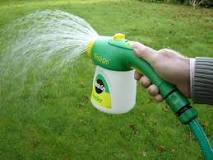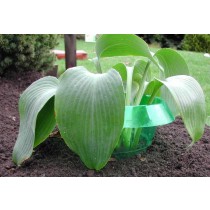Slugs & Snails
After the dry and sunny Spring 2020, the Met Office promised a day of drizzle at the beginning of meteorological summer. Ideal weather for applying slug nematodes in the Kitchen Garden. This biological treatment is my main line of defence against most gardener’s worst nightmare. Fortunately, the packet of NemaslugTM had arrived the week before and was chilling out in the fridge.
Snails also have voracious appetites for tender greens and we certainly get our fair share in the garden. NemaslugTM does not control snails. Fortunately, snails are easier to spot in the garden so just keep a wary eye out for them and collect for disposal. They do, apparently, have a homing instinct so throwing them into next door's garden provides only temporary relief and they are likely to be very hungry when they get back! Any snails we find usually end up in our hot composters where they enjoy a brief period of warmth before they are converted to soil nutrients. Other 'slug treatments' are discussed later.
NemaslugTM is administered as an aqueous dispersion, preferably to damp soil, and then watered in. So before and/or after rain is a good choice but a steady all-day drizzle is best. My first lot of nematodes were applied in mid-April, as soon as the soil was sufficiently warm (>5oC), and about a week before I start planting out those tender green vegetable plants that slugs love to devour. This first treatment coincided with a very dry spell so extra effort was needed to prewet the soil before application and then watering-in the nematodes afterwards.
This second application was going to be a doddle even though it would mean getting wet - at least it was warm rain. Under the cover of the polytunnel, I set out my basic kit:

Trug, 20-25 litre capacity, to prepare the nematode stock solution
Watering can (5-litre) with very coarse rose - I drilled larger holes in my rose to ensure the nematode dispersion did not clog it
Hosepipe with trigger gun - set to ‘centre’ to give a forceful spray, without too much splashing, in order to efficiently mix the diluted nematode stock solution
Measuring jug - I use a one-litre plastic milk bottle with the top few centimetres cut off and marked at 0.5-litre - for subsampling the stock solution
Stick for stirring the nematode stock solution prior to sampling
The 100 m2 pack of NemaslugTM is just sufficient for my Kitchen Garden. The instructions tell you to disperse all the nematodes in 10 litres of water, leave for 10 minutes, mix well and then dilute 0.5 litre of this stock solution to 5 litres in a watering can (treats up to 5 m2). I prefer to make the initial stock solution up to 20 litres so that each 0.5-litre subsample made up to 5 litres will treat 2.5 m2 of soil. I find this suits the sizes of my individual veg/fruit plots better. I have tried the hose-end feeder but it is more difficult to control in my small Kitchen Garden with its numerous raised beds - it is better suited to treating larger areas.

Every gardener has their favourite tried-and-tested method for dealing with slugs. I’ve lost count of the slug treatments I have tried over the years. I try to garden organically so metaldehyde slug pellets are a definite no-no especially since we are trying to encourage beneficial birds, insects, mammals and amphibians into the garden. Basically, protecting your plants against a slug onslaught comes down to either (i) bumping off the little, and not so little, blighters, or (ii) erecting a barrier to make the slug think twice about whether there are easier pickings elsewhere. The Royal Horticultural Society (RHS) is doing field trials on various control options and it is worthwhile checking in periodically to see the results.
NemaslugTM is the most expensive but also the most effective control in my kitchen garden. It may be less effective on clay soils. Each application gives about 6-weeks protection and there are no dead bodies to clear up afterwards. I use two applications to cover the period from mid-April to mid-July by which time the plants are big enough and sturdy enough to survive a slug attack. Nematodes do their work underground so you might want to consider additional defences to combat slugs that live above ground. I only treat the Kitchen Garden with nematodes so unwelcome visitors from other parts of the garden are always possible.
My next favourite anti-slug device is the ‘hosta halo’. A remarkably effective barrier that can be used on its own or in conjunction with other treatments such as NemaslugTM. I am always amazed at how well these work and they are effective for snails as well. After the initial outlay, these are very cost-effective; many of our 'haloes' are over 10 years old. However, I suggest you do not provide 'leaf bridges' for our mollusc friends as shown in the picture below. They can be used for vegetables and flowers; just remember to remove them before the plant gets too big otherwise they will be on show for the whole growing season.
I always keep a spray bottle of Grazer's Slugs and Snails treatment (calcium-based deterrent) and a bottle of Bayer Organic SlugBait (iron phosphate slugkiller). These should always be used sparingly.
Slug traps baited with cheap beer, lager or alternative attractants work extremely well placed on soil, paths and in the greenhouse. There are plenty of homemade variants or you can go for a commercial option like I did. Be warned though that the resultant 'slug soup' is a little disgusting and needs to be changed regularly. I've heard suggestions slug traps might actually attract slugs into the garden and make the problem worse - presumably only if they consume all your plants on the way to the slug trap.
I have never found eggshells, coffee grounds, copper tape, salt or similar physical barriers to be particularly effective. This year, I tried sheep wool pellets for the first time. I had not yet applied nematodes but I can report that there was no obvious slug damage. However, the local bird population (mainly sparrows and blackbirds) disturbed the protective 'wool mats' that form around the plants, possibly using it as a source of nesting material.
One option is to only grow plants that slugs do not regard as their food source but this is quite limiting to the kitchen gardener. You could also try planting a sacrificial crop of, for example, lettuce hoping they will eat this rather than your crops. However, this assumes the slug spends time studying the menu before deciding to go with its favourite anyway. Slugs are night-time eaters and prefer warm moist conditions - water your plants in the early morning.
There are still plenty of alternatives should none of the above options work. Some are rather extreme (electrified slug fences, keeping ducks) and others less so. You'll find plenty of options by 'googling' it.







0 comments:
Post a Comment